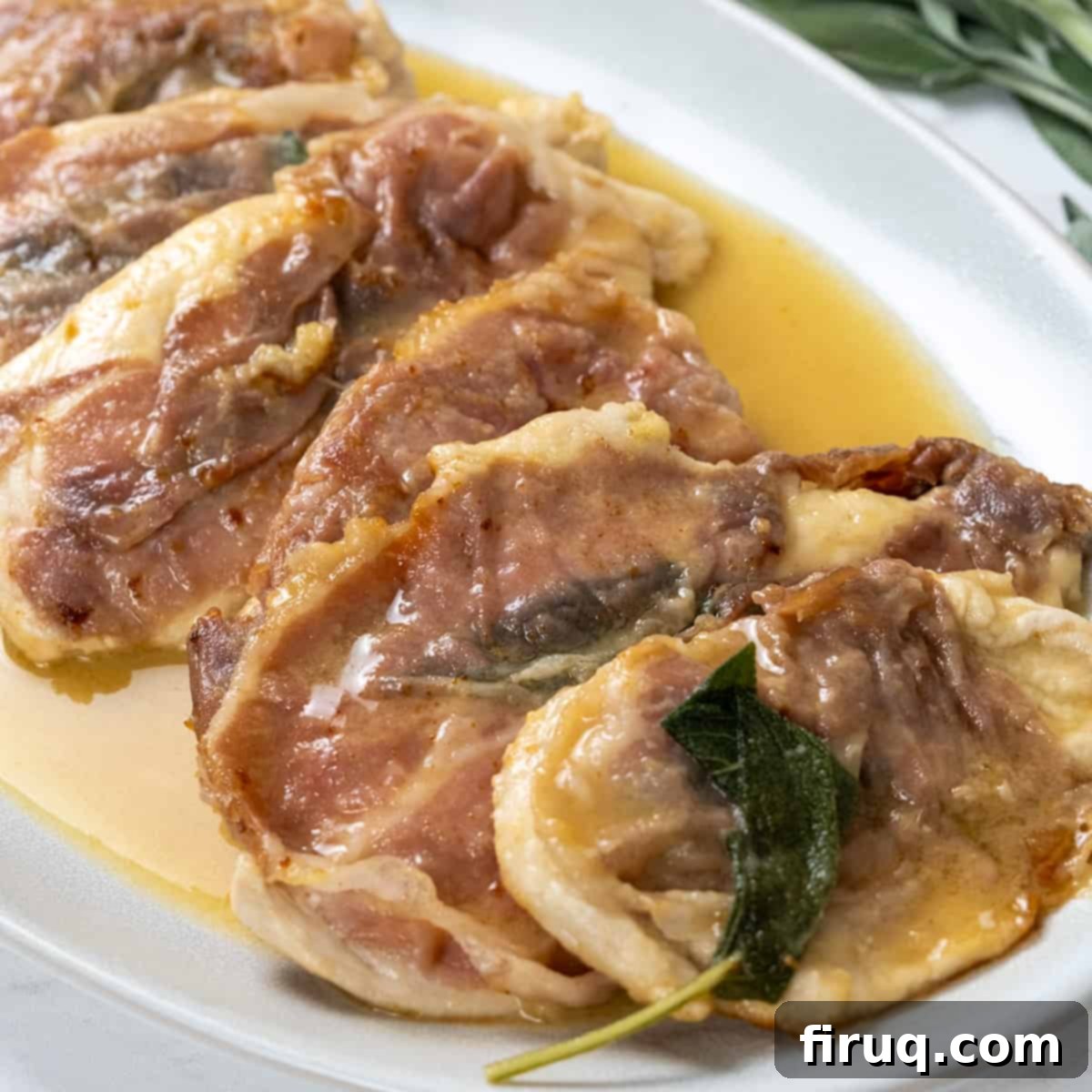Restaurant-Style Chicken Saltimbocca: An Authentic Italian Classic at Home
Prepare to fall in love with a truly exquisite Italian masterpiece: Chicken Saltimbocca. This recipe for restaurant-style chicken saltimbocca isn’t just a meal; it’s an experience. Each tender, pan-fried chicken cutlet, delicately wrapped in savory prosciutto and fresh sage, is bathed in a luxurious, silky white wine sauce. From the very first bite, you’ll be transported straight to a cozy, dimly lit Italian trattoria, perhaps in the heart of the Bronx, savoring flavors that dance on your palate.
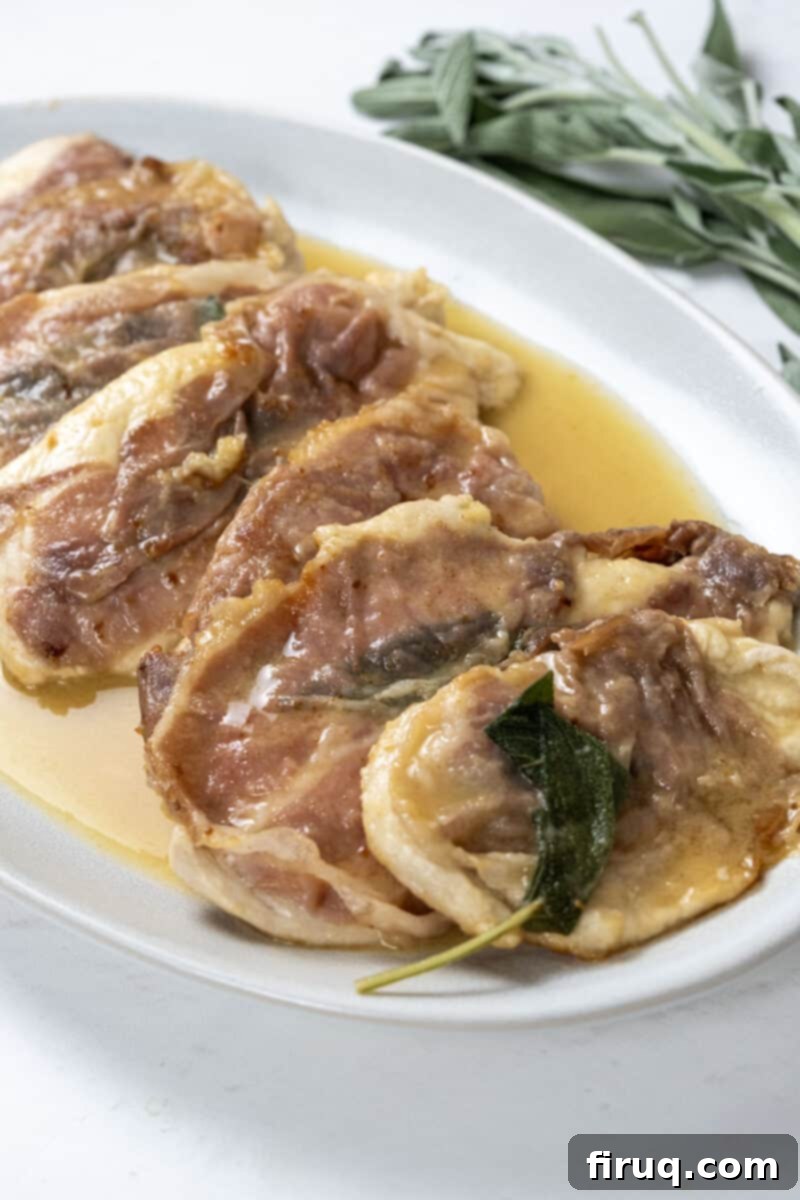
If you’re a connoisseur of classic Italian flavors, you’ll undoubtedly appreciate other timeless dishes like Authentic Italian Braciole, Easy Chicken Cacciatore, or Italian Baked Ziti.
[feast_advanced_jump_to]
Why This Chicken Saltimbocca Recipe Stands Out
My journey to perfecting Saltimbocca has been a flavorful adventure. Early in my cooking days, my first attempt to recreate this beloved dish resulted in a spicy chicken saltimbocca – delicious in its own right, but far from the classic, delicate flavors I cherished. That experience taught me invaluable lessons about precision and respecting traditional techniques.
Saltimbocca, meaning “jumps in the mouth” in Italian, truly lives up to its name with its burst of savory, aromatic, and bright flavors. It has always been one of my absolute favorite chicken dishes, with Chicken Piccata coming in at a very close second. The beauty of Saltimbocca lies in its perfectly balanced elements: the tender meat, the crisp prosciutto, the fragrant sage, and the exquisite lemon white wine sauce. Achieving this delicate balance requires attention to detail, but with a little patience and the right guidance, it’s a dish that’s incredibly rewarding to master. This recipe breaks down each critical step, ensuring you achieve that authentic, restaurant-quality taste every single time.
Key Ingredients and Smart Substitutions for Perfect Saltimbocca
Crafting exceptional Chicken Saltimbocca starts with understanding your ingredients. Here’s a deeper dive into what you’ll need and why each element is crucial:
- Chicken Breast: The foundation of this dish. For truly tender chicken that mimics the traditional veal cutlets, slicing the breasts thinly (about ¼ inch thick) and then pounding them evenly is a non-negotiable step. This ensures quick and even cooking, preventing dry, tough chicken. Don’t skip this!
- White Wine: A dry white wine is essential for deglazing the pan and forming the sauce. I personally favor Sauvignon Blanc for its crisp acidity, which beautifully cuts through the richness of the butter and prosciutto. The “Sea Salt” brand I mentioned is fantastic for both cooking and sipping! Other excellent choices include Pinot Grigio or un-oaked Chardonnay. Avoid sweet wines as they will alter the flavor profile significantly.
- Butter: Unsalted butter is preferred as it gives you complete control over the seasoning. However, salted butter will work in a pinch; just be mindful of how much additional salt you add later. Using cold butter when emulsifying into the sauce is key to achieving that smooth, glossy, restaurant-quality finish without it separating.
- Prosciutto: This Italian dry-cured ham is paramount. Its salty, savory notes are a perfect complement to the chicken and sage. Ensure it’s thinly sliced; thicker cuts can become chewy or unpleasantly tough when seared.
- Fresh Sage Leaves: The signature herb of Saltimbocca, offering an earthy, slightly peppery aroma and flavor. Fresh sage is a must; dried sage simply won’t deliver the same vibrant taste.
- All-Purpose Flour: Used for dredging the chicken, it helps create a delicate crust when pan-fried and slightly thickens the sauce, giving it body.
- Lemon Juice: Freshly squeezed lemon juice is added at the end to brighten the rich sauce, providing a much-needed acidic counterpoint that elevates all the other flavors.
- Olive Oil: A good quality extra virgin olive oil for searing the chicken.
- Salt and Freshly Ground Black Pepper: Seasoning is crucial at every stage to enhance the natural flavors of the ingredients.
How to Make Restaurant-Quality Chicken Saltimbocca at Home
True Saltimbocca is considered a challenging dish by many home cooks, and for good reason. It’s easy to overcook the delicate chicken, or end up with a watery, separated sauce, or even worse, prosciutto that turns into a rubbery, gray mess. Trust me, I’ve made all these mistakes!
This recipe is designed to help you avoid those pitfalls. I’ll guide you step-by-step through the process, explaining the ‘why’ behind each technique, so you can achieve a perfectly tender chicken with a rich, unctuous sauce every time.
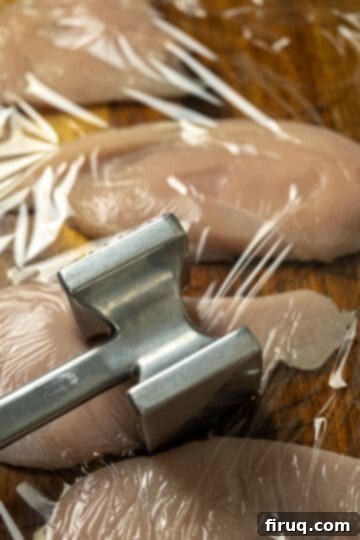
Step 1: Prepare the Chicken. Begin by preparing your chicken breasts. Slice them thinly, aiming for about 1/4 inch thickness. While traditional saltimbocca uses veal, which is naturally thinner and more tender, we can achieve a similar texture with chicken by thoroughly pounding it out. Place the thinly sliced chicken cutlets between two sheets of plastic wrap or in a large zip-top bag. Using a meat mallet or the bottom of a heavy pan, gently but firmly pound the chicken until it’s about ⅛-inch thick. This crucial step ensures the chicken cooks quickly and remains incredibly tender.
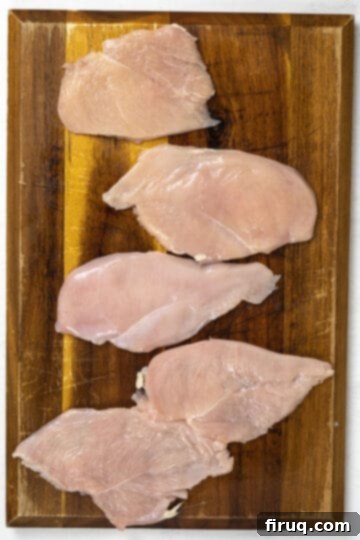
Step 2: Achieve the Ideal Thickness. From each average-sized chicken breast, I typically aim to slice 4 cutlets. Once sliced, cover them with plastic wrap and gently pound them. The goal is an even thickness across all pieces, which ensures they cook at the same rate and remain incredibly tender, just like veal.
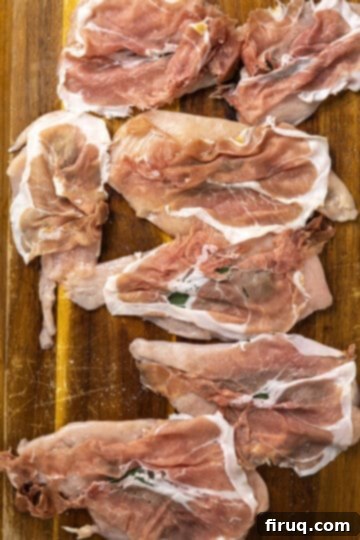
Step 3: Layer with Sage and Prosciutto. On each prepared chicken cutlet, place a single fresh sage leaf. Then, lay a slice of prosciutto neatly over the sage, ensuring it covers the leaf. Now, for the secret: “smack” the prosciutto onto the chicken. Don’t be shy – literally give it a firm smack. This helps the prosciutto adhere firmly to the chicken and sage, preventing it from curling up or detaching during cooking.
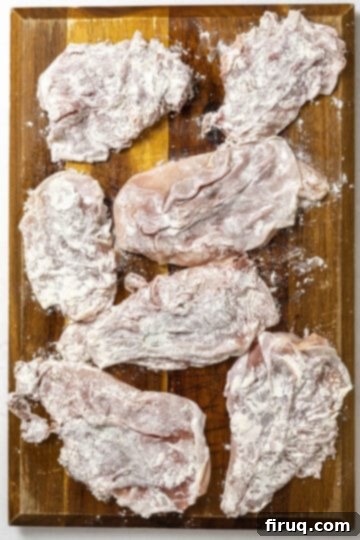
Step 4: Season and Dredge. Some recipes suggest using toothpicks to secure the prosciutto, but if you’ve smacked it on well, it’s often unnecessary. Before dredging, lightly salt the chicken side of each cutlet. Then, dredge only the chicken side (not the prosciutto side) in all-purpose flour. This light coating of flour will create a beautiful golden crust when fried and will also help thicken our delicious sauce later.
Frying the Chicken to Perfection
Step 5: Sear the Chicken. Heat 1 tablespoon of olive oil in a large frying pan over medium-high heat. The key here is quick searing. Place the chicken cutlets, prosciutto-side down, into the hot pan. Let it sear for a mere 15 seconds. The goal is to just let the prosciutto “kiss” the pan – you want it to lightly crisp and impart its flavor, not cook through and become tough or gray. Immediately flip the chicken to the plain chicken side. Continue to sauté the chicken on this side for about 5 minutes, or until it turns a beautiful golden brown and is nearly cooked through. Remove the chicken from the pan and set aside.
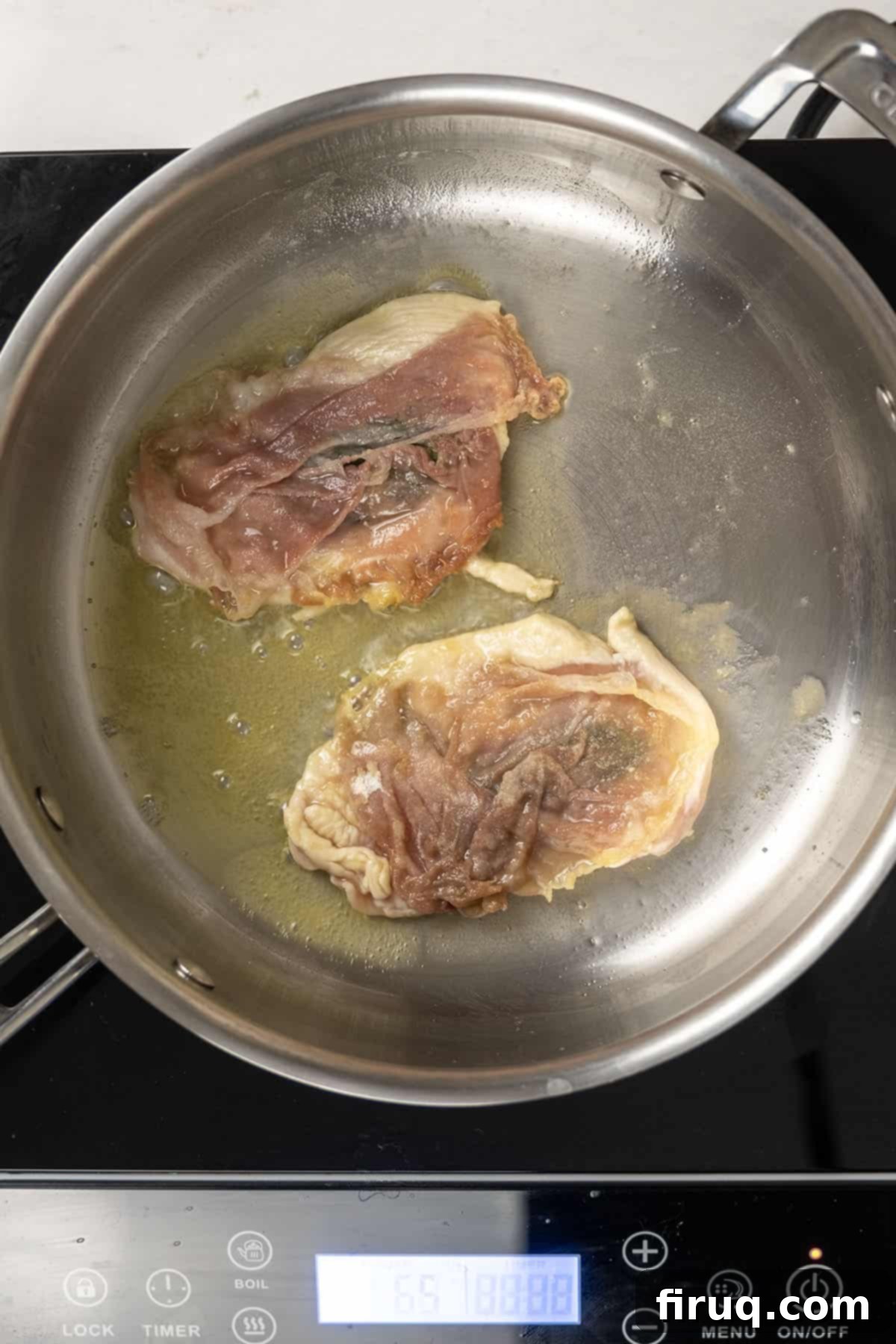
As mentioned, flip to the chicken side and sauté in the olive oil on medium heat for about 5 minutes or until golden brown. This ensures thorough cooking without burning the prosciutto.
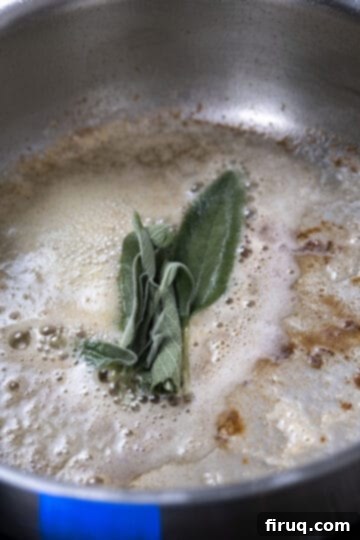
Step 6: Infuse Butter with Sage. In the same pan, reduce the heat slightly and add 2 tablespoons of butter. Toss in a few extra fresh sage leaves. Allow the butter to melt and foam. As the foaming subsides, the sage will have infused its beautiful aroma into the butter. Remove and discard these sage leaves to prevent them from burning and becoming bitter.
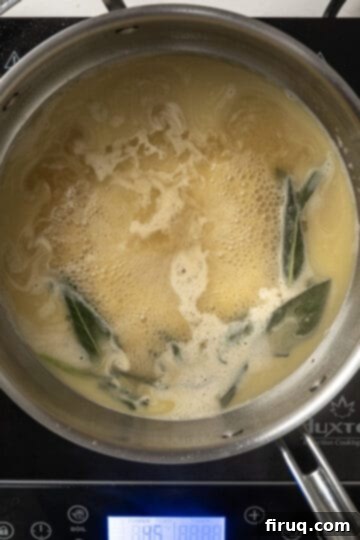
Step 7: Deglaze with White Wine. Pour in the dry white wine. Increase the heat slightly and bring the wine to a gentle simmer. As it simmers, use a wooden spoon to scrape up any browned bits (known as “fond”) from the bottom of the pan. These bits are packed with flavor and will contribute immensely to the richness of your sauce. Let the wine reduce slightly, allowing some of the alcohol to cook off.
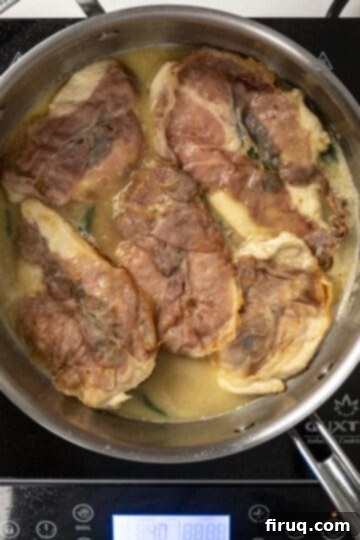
Step 8: Finish Cooking the Chicken. Return the partially cooked chicken cutlets to the pan with the simmering white wine sauce. Allow them to gently simmer in the sauce until they reach an internal temperature of 165 degrees Fahrenheit. Using a meat thermometer is highly recommended here to avoid overcooking, which can quickly dry out the thinly pounded chicken.
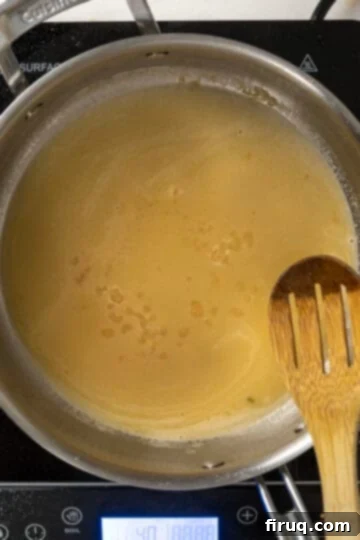
Step 9: Perfect the Sauce and Serve. Once the chicken is cooked, carefully remove it from the pan and keep it warm. Allow the sauce to continue simmering and reduce slightly until it achieves your desired consistency – a beautiful, slightly thickened glaze. Squeeze in the fresh lemon juice and stir it well. Taste and adjust seasoning if needed. Finally, generously pour the luscious sauce over the waiting chicken cutlets and serve immediately. Buon Appetito!
Pro-Tips for Saltimbocca Success
Achieving that authentic restaurant-quality Saltimbocca takes a few insider tricks. Here are my top pro-tips to ensure your dish is nothing short of spectacular:
- Mastering the Prosciutto Sear: When you’re searing the prosciutto side, remember, you’re not trying to cook the prosciutto through; you’re merely aiming to get the slightest crust and to render out some of its fat to infuse flavor into the pan. This is why just 15 seconds on that side is absolutely plenty. Any longer, and the prosciutto will become tough, chewy, and lose its beautiful pink hue, turning an unappetizing gray.
- Preventing Sauce Separation: It is surprisingly easy for the delicate white wine butter sauce to separate and become oily if the heat is too high or it’s over-reduced. Ideally, your sauce should be an opaque, yellowish, and emulsified consistency. If you start to notice the oil separating from the liquid, don’t panic! This can often be remedied. Immediately remove the pan from the heat and add 2 tablespoons of cold water. Stir vigorously. The cold water can help bring the emulsion back together, making the sauce look creamy and unified again. For next time, simply remember to keep your heat a little lower when simmering the sauce.
- Pounding for Tenderness: The thinner and more evenly you pound the chicken, the better. This not only speeds up cooking but also ensures every bite is incredibly tender, truly mimicking the traditional veal cutlets Saltimbocca is known for. Aim for uniform ⅛-inch thickness.
- Fresh Sage is Key: While dried herbs have their place, Saltimbocca demands fresh sage. The aromatic, slightly peppery notes of fresh sage are irreplaceable and contribute significantly to the dish’s classic flavor profile.
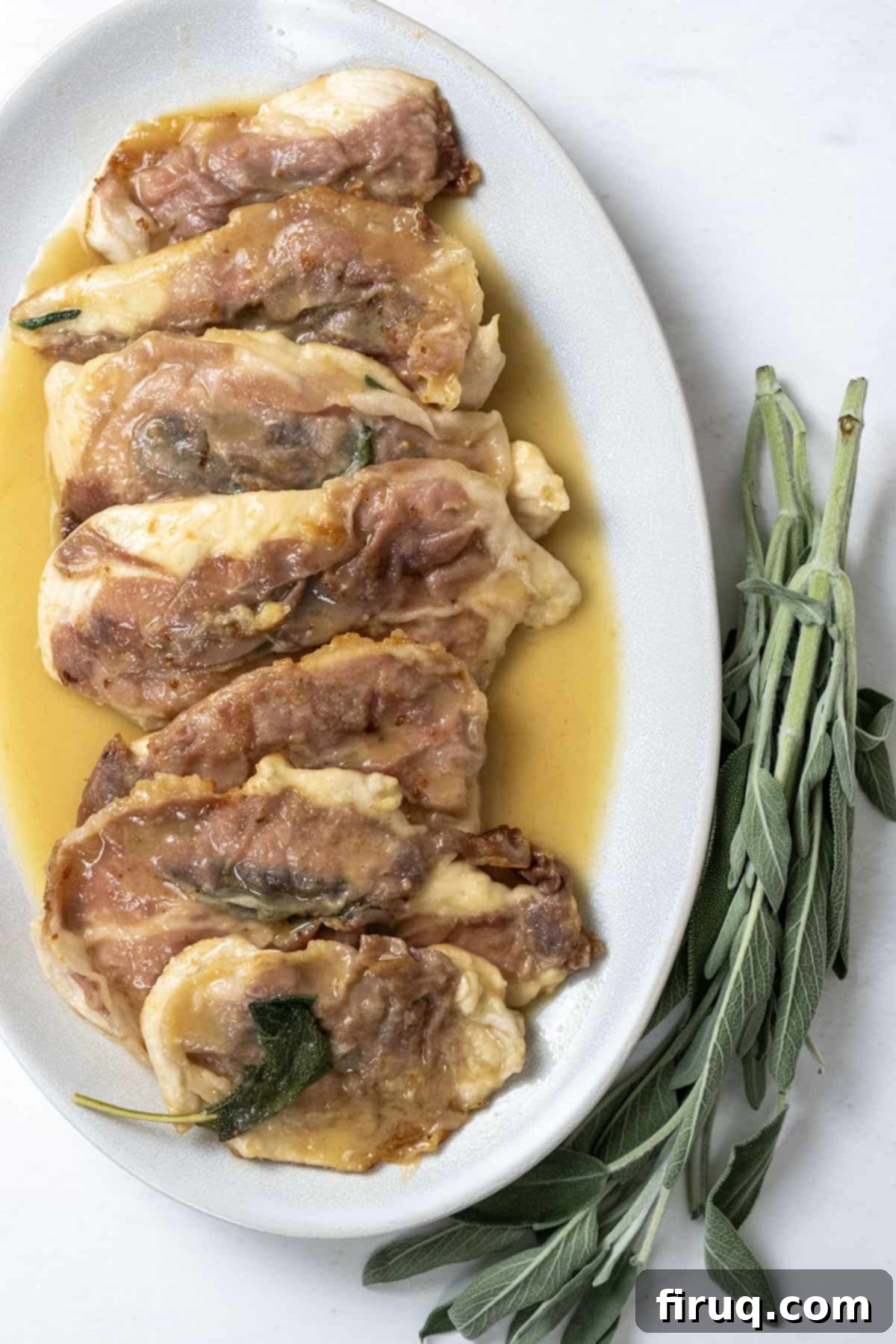
Reheating Chicken Saltimbocca: Best Practices
Due to the delicate nature of the thinly sliced chicken and the prosciutto, Chicken Saltimbocca is best enjoyed fresh, immediately after it’s prepared. The magic of its texture and flavor is at its peak when served straight from the pan. For this reason, I generally don’t recommend making it for meal prep or planning for significant leftovers.
If you absolutely must reheat it, be aware that achieving the original quality can be challenging. Microwaving is usually the worst option, as it will inevitably dry out the chicken and make the prosciutto rubbery and overcooked, dramatically altering the taste and texture. Instead, I suggest a gentler approach:
Place a small amount of butter in a pan with a splash of chicken broth (or even a little white wine). Bring this mixture to a gentle simmer over low heat. Once simmering, add your leftover chicken cutlets to the pan. Cover and warm gently for just a few minutes, flipping once, until the chicken is heated through. The added moisture from the broth and butter can help to retain some of the chicken’s tenderness and prevent it from drying out completely. However, please manage your expectations; it won’t be quite the same as fresh.
Chicken Saltimbocca Recipe FAQs
Chicken Saltimbocca offers a wonderfully complex yet harmonious flavor profile. The most prominent flavor comes from the earthy and aromatic sage, which is beautifully balanced by the savory, slightly salty notes of the crispy prosciutto. A vibrant lemon white wine sauce ties everything together, adding a bright, acidic zest that cuts through the richness and leaves a refreshing finish. It’s truly a “jump in the mouth” experience!
A truly restaurant-style Chicken Saltimbocca can be considered a challenging dish to master initially, primarily because of the precise timing required to prevent the chicken from overcooking and the sauce from separating. However, with the detailed, step-by-step guidance provided in THIS BLOG, and a focus on understanding the techniques, it is absolutely achievable for home cooks. The key is to be prepared, move quickly, and pay close attention to the details. It took me a couple of tries to perfect the sauce, so don’t be discouraged if it’s not flawless on your first attempt!
The name “Saltimbocca” is Italian for “jumps in the mouth.” This evocative name perfectly describes the dish’s delightful burst of flavors and how quickly and eagerly you’ll want to savor each bite!
Traditionally, Saltimbocca is made with veal (Saltimbocca alla Romana). However, chicken is a popular and delicious alternative, offering a more accessible and often leaner option while still delivering incredible flavor when prepared correctly, as shown in this recipe.
What Should I Serve with Saltimbocca?
Chicken Saltimbocca is a versatile dish that pairs beautifully with a variety of sides, allowing you to create a complete and satisfying Italian meal. Here are some of my favorite recommendations:
- Vegetable Sides: I love a vibrant vegetable side dish to complement the richness of Saltimbocca. Consider serving it with the wholesome Italian Cabbage, the nutritious and flavorful Italian Lacinato Kale, or for a touch of savory sweetness, our Maple Bacon Brussels Sprouts!
- Soups: For a lighter accompaniment or to start your meal, a comforting bowl of soup is perfect. This dish would go wonderfully with a hearty white bean and lentil soup or the incredibly rich and satisfying creamy mushroom mascarpone soup.
- Pasta Dishes: Saltimbocca and pasta are a match made in culinary heaven. Serve it alongside a classic Bucatini Amatriciana, the ever-popular Spaghetti Carbonara, or for a burst of bold flavor, garlic anchovy pasta. A simple side of buttered noodles or angel hair pasta also works beautifully to soak up that exquisite sauce.
- Desserts: No classic Italian meal is complete without a delightful dessert. Conclude your feast with a decadent Pistachio-cream tiramisu or the festive and colorful Rainbow Cookie Cake for a truly memorable dining experience.
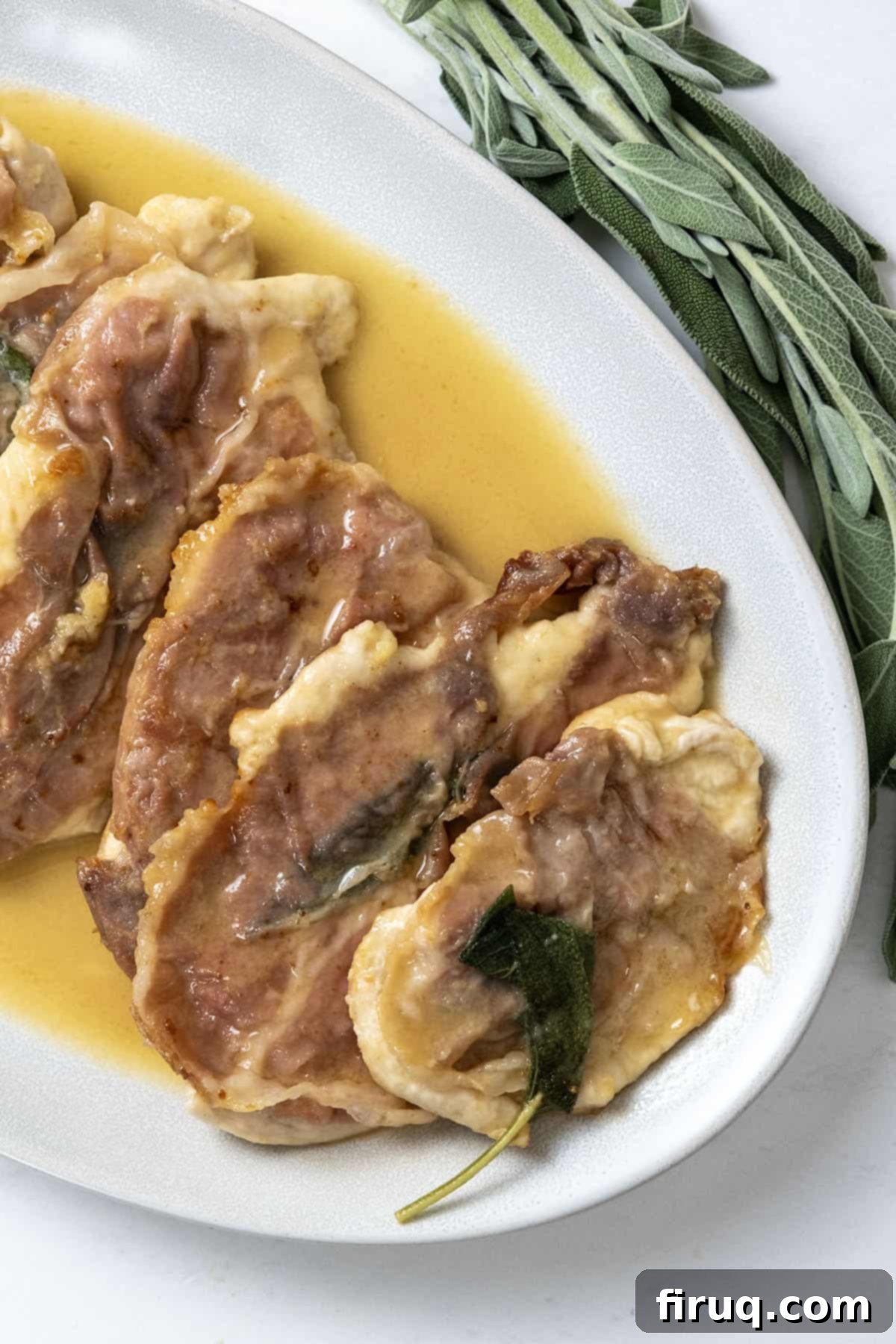
Watch the Video: Restaurant-Style Chicken Saltimbocca
Explore More of Our Favorite Italian Classics
If you’ve enjoyed mastering this incredible Chicken Saltimbocca, you’re in for a treat! We have a passion for authentic Italian cuisine and love sharing recipes that bring the true flavors of Italy into your home. Discover more of our cherished Italian classic recipes:
- Restaurant-Style Chicken Marsala
- Restaurant-Style Chicken Francese
- The BEST Chicken Pizzaiola
- Pasta alla Norma (A Sicilian Dish)
If you loved this restaurant-style chicken saltimbocca, we would be thrilled if you left us a review below! Tell us about your first experience with Saltimbocca or what you thought of our recipe. Your feedback is invaluable. Don’t forget to follow us on Instagram @vindelgiudice and Tiktok @alwaysfromscratch for more delicious recipes and cooking tips!
📖 Recipe
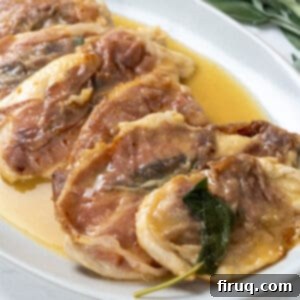
Restaurant-Style Chicken Saltimbocca
Vincent DelGiudice
Pin Recipe
15 minutes
30 minutes
45 minutes
Main Course
Italian
6
servings
407
kcal
Equipment
-
1 large pan
Ingredients
-
2-3 chicken breasts, sliced thin and pounded -
8 oz thinly sliced prosciutto -
1 bunch fresh sage leaves -
1 cup dry white wine (e.g., Sauvignon Blanc, Pinot Grigio) -
3 tablespoon fresh lemon juice -
3 tablespoon cold unsalted butter, cut into pieces -
½ cup all-purpose flour for dredging -
2-3 tablespoon olive oil -
salt and freshly ground black pepper to taste
Instructions
-
Prepare chicken by slicing it thin (about ¼ inch) and pounding it to an even ⅛-inch thickness. Top each cutlet with 1 sage leaf, then lay a slice of prosciutto over the sage. Firmly “smack” the prosciutto onto the chicken to help it adhere. Season the chicken side with salt, then dredge only the chicken side in flour.
-
In a large frying pan, heat 1 tablespoon of olive oil over medium-high heat. Place the chicken cutlets, prosciutto-side down, in the hot pan for exactly 15 seconds. Immediately flip to the chicken side and fry until golden brown, about 5 minutes. Remove the chicken from the pan and set aside on a plate.
-
In the same pan, reduce heat slightly and add 2 tablespoons of butter along with a few extra sage leaves. Once the butter melts and the foaming subsides, remove and discard the sage leaves. Pour in the white wine and bring to a gentle simmer, scraping up any browned bits from the bottom of the pan. Return the seared chicken to the sauce and continue simmering until the chicken reaches an internal temperature of 165 ℉.
-
Remove the chicken from the sauce and keep warm. Continue to simmer the sauce, allowing it to reduce and thicken slightly for 3-5 minutes. Stir in the fresh lemon juice.
-
Generously pour the finished sauce over the chicken and serve immediately. Enjoy your homemade restaurant-style Chicken Saltimbocca!
Notes
- When searing the prosciutto side, you’re merely trying to get the slightest crust and render some fat, not cook it through. So just 15 seconds on that side is absolutely plenty to prevent it from turning gray and chewy.
- It is very easy for the white wine sauce to separate and become oily if the heat is too high. It should be an opaque yellowish color. If you start seeing the oil separate, add 2 tablespoons of cold water. Stir it vigorously, and it should come back together, looking yellowish and creamy again. Next time, try lowering your heat just a little bit more for the sauce.
Nutrition
Calories:
407
kcal
Carbohydrates:
11
g
Protein:
21
g
Fat:
27
g
Saturated Fat:
10
g
Polyunsaturated Fat:
3
g
Monounsaturated Fat:
12
g
Trans Fat:
0.3
g
Cholesterol:
88
mg
Sodium:
385
mg
Potassium:
401
mg
Fiber:
0.3
g
Sugar:
1
g
Vitamin A:
212
IU
Vitamin C:
4
mg
Calcium:
38
mg
Iron:
1
mg
Tried this recipe?
We’d love for you to Leave a Review!
